Analysis of Height of the Stable Boundary Layer in Summer and Its Influencing Factors in the Taklamakan Desert Hinterland
Abstract
1. Introduction
2. Materials and Methods
2.1. Study Area
2.2. Data and Instruments
2.3. Methods
2.3.1. SBLH Calculation Method
2.3.2. Pearson Correlation Analysis
2.3.3. Changes in SBLH and Near-Surface Meteorological Factors
2.3.4. Linear Regression Analysis
2.3.5. Variable Importance Projection
3. Results
3.1. Characteristics of Summer SBLH Changes in the Hinterland of the TD
3.2. Analysis of Influencing Factors of Summer SBLH in the TD Hinterland
3.2.1. Influence of Near-Ground Thermal Factors on SBLH
3.2.2. Influence of Near-Ground Dynamic Factors on SBLH
3.2.3. The Impact of Other Factors on SBLH
3.3. Quantitative Analysis of Key Influencing Factors of SBLH
3.3.1. Quantitative Analysis of Key Thermodynamic Factors Influencing SBLH Changes
3.3.2. Quantification of Key Motility Factors Influencing SBLH Changes
3.3.3. Quantification of Other Key Factors Influencing Changes in SBLH
3.4. Model Validation
3.5. Possible Mechanism of SBLH Formation
4. Discussion
5. Conclusions
- (1)
- The SBLH at TZ is extremely close to the same moment in different years, and the development of SBLH is relatively stable at night; the overall daily average SBLH ranged between 100 and 500 m. In July, the average SBLH values were 265, 263, and 313 m, with median values of 169, 184, and 209 m and extreme maximum values of 964, 1192, and 1270 m in 2017, 2019, and 2021, respectively, all showing a trend of increasing over time. The daily cycle amplitudes of SBLH in July were 5–570 m, 2–1132 m, and 20–868 m in 2017, 2019, and 2021, respectively, showing an increasing trend over time. The peak frequencies of the SBLH were 30–18, 23–200, and 100–200 m, respectively, which were relatively concentrated.
- (2)
- The results of correlation analysis showed that the thermal factors strongly correlated with the SBLH included surface long wave radiation (ULR) and air temperature at different heights (Ta); the dynamic factors included wind speed (WS) and friction velocity (u*) at different heights; the other factors included relative humidity (RH) at different heights. At the 0.01 level, the r values were 0.588, 0.52, 0.622, 0.598, and −0.334, respectively.
- (3)
- The results of linear regression analysis show that the thermal factors that significantly impacted the change in SBLH (ΔSBLH) included the ΔTs-Ta at different heights ΔTa; the power factors included Δu* and ΔTKE at different heights and ΔWS; other factors included ΔSH. For every increase (decrease) of one unit in each meteorological factor, the SBLH increased (decreased) by 106.475, 30.895, 1133.062, 137.326, 65.909, and −68.724 m, respectively.
- (4)
- The TD hinterland SBLH is affected by a combination of dynamical and thermal factors. Among the meteorological factors that play a key role (VIP ≥ 1) in the variation of the SBLH, WS2, WS4, u*, WS10, and WS0.5 are ranked high, suggesting that the dynamical effect has a greater influence on the development of the desert hinterland SBLH.
- (5)
- Thermal and dynamic effects play important roles in the mechanism of SBLH formation, jointly influencing its development. From the perspective of thermal effects, at night, the ground dissipates heat into the atmosphere through ULR, and the intensification of surface radiative cooling leads to the formation of an inversion layer, thereby promoting the development of SBLH. From the perspective of dynamic effects, the night-time low-level jet strengthens wind shear, thereby reducing atmospheric stability, reducing the forcing effect of the underlying surface, improving atmospheric diffusion capacity, and promoting the development of the SBLH.
Supplementary Materials
Author Contributions
Funding
Data Availability Statement
Acknowledgments
Conflicts of Interest
References
- Zhou, C.L.; Liu, Y.Z.; He, Q.; Zhong, X.J.; Zhu, Q.Z.; Yang, F.; Huo, W.; Mamtimin, A.; Yang, X.H.; Wang, Y.; et al. Dust Characteristics Observed by Unmanned Aerial Vehicle over the Taklamakan Desert. Remote Sens. 2022, 14, 990. [Google Scholar] [CrossRef]
- Jin, H.X.; Zhang, N.; Lu, C.; Yang, H.L.; Qiu, Z.X. Novel Method for Determining the Height of the Stable Boundary Layer under Low-Level Jet by Judging the Shape of the Wind Velocity Variance Profile. Remote Sens. 2023, 15, 3638. [Google Scholar] [CrossRef]
- Wei, Z.G.; Chen, W.; Huang, R.H. Characteristics of vertical structure and boundary layer height in Dunhuang in late summer. Atmos. Sci. 2010, 34, 905–913. [Google Scholar]
- Cai, J.Y.; Miao, S.G.; Li, J.; Pan, Y.B.; Quan, J.N.; Chen, Z.G. Two-step curve fitting method for inversion of all-sky boundary layer height based on laser cloud altimeter. J. Meteorol. 2020, 78, 864–876. [Google Scholar]
- Gassmann, M.I.; Mazzeo, N.A. Nocturnal stable boundary layer height model and its application. Atmos. Res. 2001, 57, 247–259. [Google Scholar] [CrossRef]
- Hyun, Y.K.; Kim, K.E.; Ha, K.J. A comparison of methods to estimate the height of stable boundary layer over a temperate grassland. Agric. For. Meteorol. 2005, 132, 132–142. [Google Scholar] [CrossRef]
- Wang, W.; Mao, F.Y.; Gong, W.; Pan, Z.X.; Du, L. Evaluating the Governing Factors of Variability in Nocturnal Boundary Layer Height Based on Elastic Lidar in Wuhan. Int. J. Environ. Res. Public Health 2016, 13, 1071–1082. [Google Scholar] [CrossRef] [PubMed]
- Aryee, J.N.A.; Amekudzi, L.K.; Preko, K.; Atiah, W.A.; Danuor, S.K. Estimation of planetary boundary layer height from radiosonde profiles over West Africa during the AMMA field campaign: Intercomparison of different methods. Sci. Afr. 2020, 7, e00228. [Google Scholar] [CrossRef]
- Vogelezang, D.H.P.; Holtslag, A.A.M. Evaluation and model impacts of alternative boundary-layer height Formulations. Bound-Layer Meteor. 1996, 81, 245–269. [Google Scholar] [CrossRef]
- Collaud Coen, M.; Praz, C.; Haefele, A.; Ruffieux, D.; Kaufmann, P.; Calpini, B. Determination and climatology of the planetary boundary layer height above the Swiss plateau by in situ and remote sensing measurements as well as by the COSMO-2 model. Atmos. Chem. Phys. 2014, 14, 13205–13221. [Google Scholar] [CrossRef]
- Mahrt, L.; Heald, R.C.; Lenschow, D.H.; Stankov, B.B.; Troen, I.B. An observational study of the structure of the nocturnal boundary layer. Bound.-Layer Meteorol. 1979, 17, 247–264. [Google Scholar] [CrossRef]
- Beyrich, F. Mixing height estimation from sodar data: A critical discussion. Atmos. Environ. 1997, 31, 3941–3953. [Google Scholar] [CrossRef]
- Liu, S.Y.; Liang, X.Z. Observed Diurnal Cycle Climatology of Planetary Boundary Layer Height. J. Clim. 2010, 23, 5790–5809. [Google Scholar] [CrossRef]
- Han, S.Q.; Hai, B.; Tie, X.X.; Xie, Y.Y.; Sun, M.L.; Liu, A.X. Impact of nocturnal planetary boundary layer on urban air pollutants: Measurements from a 250-m tower over Tianjin, China. J. Hazard. Mater. 2009, 162, 264–269. [Google Scholar] [CrossRef] [PubMed]
- Heutte, B.J.L. Climatology of Atmospheric Boundary Layer Height Over Switzerland. Master’s Thesis, Bundesamt für Meteorologie und Klimatologie MeteoSchweiz, Zürich, Switzerland, 2021. [Google Scholar]
- Sokół, P.; Stachlewska, I.S.; Ungureanu, I.; Stefan, S. Evaluation of the boundary layer morning transition using the CL-31 ceilometer signals. Acta Geophys. 2014, 62, 367–380. [Google Scholar] [CrossRef]
- Levi, Y.; Dayan, U.; Levy, I.; Broday, D.M. On the association between characteristics of the atmospheric boundary layer and air pollution concentrations. Atmos. Res. 2020, 231, 104675. [Google Scholar]
- Seidel, D.J.; Ao, C.O.; Li, K. Estimating climatological planetary boundary layer heights from radiosonde observations: Comparison of methods and uncertainty analysis. J. Geophys. Res. 2010, 115, D16113. [Google Scholar] [CrossRef]
- Zhang, Y.J.; Sun, K.; Gao, Z.Q.; Pan, Z.T.; Michael, A.S.; Li, D. Diurnal climatology of planetary boundary layer height over the contiguous United States derived from AMDAR and reanalysis data. J. Geophys. Res. Atmos. 2020, 125, e2020JD032803. [Google Scholar] [CrossRef]
- Hanna, S.R. The thickness of the planetary boundary layer. Atmos. Environ. 1969, 3, 519–536. [Google Scholar] [CrossRef]
- Guo, J.P.; Miao, Y.C.; Zhang, Y.; Liu, H.; Li, Z.Q.; Zhang, W.C.; He, J.; Lou, M.Y.; Yan, Y.; Bian, L.G.; et al. The climatology of planetary boundary layer height in China derived from radiosonde and reanalysis data. Atmos. Chem. Phys. 2016, 16, 13309–13319. [Google Scholar] [CrossRef]
- Etling, D.; Wippermann, F. The height of the planetary boundary layer and of the surface layer. Beitr. Phys. Frei. Atmos. 1975, 48, 250–254. [Google Scholar]
- Arya, S.P.S. Parameterizing the height of the stable atmospheric boundary layer. J. Appl. Meteorol. 1981, 20, 1192–1202. [Google Scholar] [CrossRef]
- Koracin, D.; Berkowicz, R. Nocturnal boundary layer height: Observations by acoustic sounders and prediction in terms of surface layer parameters. Bound. Layer Meteorol. 1988, 43, 65–83. [Google Scholar] [CrossRef]
- Seidel, D.J.; Zhang, Y.H.; Beljaars, A.; Golaz, J.C.; Jacobson, A.R.; Medeiros, B. Climatology of the planetary boundary layer over the continental United States and Europe. J. Geophys. Res. Atmos. 2012, 117, D17. [Google Scholar] [CrossRef]
- Chen, X.L.; Skerlak, B.; Rotach, M.W.; Añel, J.A.; Su, B.; Ma, Y.M.; Li, J. Reasons for the Extremely High-Ranging Planetary Boundary Layer over the Western Tibetan Plateau in Winter. J. Atmos. Sci. 2016, 73, 2021–2038. [Google Scholar] [CrossRef]
- Huo, Y.F.; Wang, Y.H.; Paasonen, P.; Liu, Q.; Tang, G.Q.; Ma, Y.Y.; Petaja, T.; Kerminen, V.M.; Kulmala, M. Trends of Planetary Boundary Layer Height Over Urban Cities of China From 1980–2018. Front. Environ. Sci. 2021, 9, 744255. [Google Scholar] [CrossRef]
- Zhang, H.S.; Zhang, X.Y.; Li, Q.H.; Cai, X.H.; Fan, S.J.; Song, Y.; Hu, F.; Che, H.Z.; Quan, J.N.; Kang, L.; et al. Research progress on determination and application of atmospheric boundary layer height. J. Meteorol. 2020, 78, 522–536. [Google Scholar]
- Seibert, P.; Beyrich, F.; Gryning, S.E.; Joffre, S.; Rasmussen, A.; Tercierf, P. Review and intercomparison of operational methods for the determination of the mixing height. Atmos. Environ. 2000, 34, 1001–1027. [Google Scholar] [CrossRef]
- Faccani, C.; Rabier, F.; Fourrié, N.; Panareda, A.A.; Karbou, F.; Moll, P.; Lafore, J.-P.; Nuret, M.; Hdidou, M.; Bock, O. The impact of the AMMA radiosonde data on the French global assimilation and forecast system. Weather Forecast. 2009, 24, 1268–1286. [Google Scholar] [CrossRef]
- Yao, S. L-Band Radiosonde Data Analysis and Assimilation Experiment in Meso-Scale Model. Master’s Thesis, Chinese Academy of Meteorological Sciences, Beijing, China, 2014. [Google Scholar]
- Li, Q.L.; Yuan, F.; Yang, G.; Liao, J.; Hu, K.X.; Yao, S.; Zhou, Z.J. A sparsification scheme and evaluation of the L-band radiosonde high-resolution data. Adv. Meteor. Sci. Technol. 2018, 8, 127–132. [Google Scholar]
- Zhang, Q. A review of atmospheric boundary layer meteorology. Arid Weather 2003, 21, 74–78. [Google Scholar]
- Qiao, J.; Zhang, Q.; Zhang, J.; Wang, S. Comparative study of atmospheric boundary layer structure in winter and summer in the arid region of Northwest China. Chin. Desert 2010, 30, 422–431. [Google Scholar]
- Wang, M.Z.; Wei, W.S.; He, Q.; Yang, Y.H.; Fan, L.; Zhang, J.T. Summer atmospheric boundary layer structure in the hinterland of Taklamakan Desert. China J. Arid Land 2016, 8, 846–860. [Google Scholar] [CrossRef][Green Version]
- Wang, M.Z.; Lu, H.; Ming, H.; Zhang, J.T. Vertical structure of summer clear-sky atmospheric boundary layer over the hinterland and southern margin of Taklamakan Desert. Meteorol. Appl. 2016, 23, 438–447. [Google Scholar] [CrossRef]
- Wei, W.; Wang, M.Z.; Zhang, H.S.; He, Q.; Mamtimin, A.; Wang, Y.J. Diurnal characteristics of turbulent intermittency in the Taklamakan Desert. Meteorol. Atmos. Phys. 2019, 131, 287–297. [Google Scholar] [CrossRef]
- Zhang, X.Y.; Xu, X.Y.; Chen, H.S.; Hu, X.M.; Gao, L. Dust-planetary boundary layer interactions amplified by entrainment and advections. Atmos. Res. 2022, 275, 106359. [Google Scholar] [CrossRef]
- Han, B.S.; Zhou, T.; Zhou, X.W.; Fang, S.Y.; Huang, J.P.; He, Q.; Huang, Z.W.; Wang, M.Z. A New Algorithm of Atmospheric Boundary Layer Height Determined from Polarization Lidar. Remote Sens. 2022, 14, 5436. [Google Scholar] [CrossRef]
- Zhang, Y.H.; Zhang, S.D.; Huang, C.M.; Huang, K.M.; Gong, Y.; Gan, Q. Diurnal variations of the planetary boundary layer height estimated from intensive radiosonde observations over Yichang, China. Sci. China Technol. Sci. 2014, 57, 2172–2176. [Google Scholar] [CrossRef]
- Sathyanadh, A.; Prabhakaran, T.; Patil, C.; Karipot, A. Planetary boundary layer height over the Indian subcontinent: Variability and controls with respect to monsoon. Atmos. Res. 2017, 195, 44–61. [Google Scholar] [CrossRef]
- Guo, J.P.; Li, Y.; Cohen, J.B.; Li, J.; Chen, D.; Xu, H.; Liu, L.; Yin, J.F.; Hu, K.X.; Zhai, P.M. Shift in the temporal trend of boundary layer height in China using long-term (1979–2016) radiosonde data. Geophys. Res. Lett. 2019, 46, 6080–6089. [Google Scholar] [CrossRef]
- Sudeepkumar, B.L.; Babu, C.A.; Varikoden, H. Atmospheric boundary layer height and surface parameters: Trends and relationships over the west coast of India. Atmos. Res. 2020, 245, 105050. [Google Scholar] [CrossRef]
- Li, Y.Y.; Zhang, Q.; Zhang, A.P.; Chen, Y.; Yang, M. Characteristics of boundary layer change and its influencing factors in arid and semi-arid region. Plateau Meteorol. 2016, 35, 385–396. [Google Scholar]
- Zhang, J.T.; He, Q.; Wang, M.Z.; Jin, L.L. A case study of stable boundary layer observation at night in the hinterland of Taklamakan Desert. Plateau Meteorol. 2018, 37, 826–836. [Google Scholar]
- Zhang, l.; Peng, Y.; Li, Q.H.; Zhang, H.S.; He, Q.; Mamtimin, A. Characteristics of near-surface turbulence and differences in heat and momentum transport in the Taklamakan Desert in summer and their causes. J. Peking Univ. (Nat. Sci. Ed.) 2023, 59, 581–592. [Google Scholar]
- Wu, W.L. The Main Influencing Factors and Regional Differences of Boundary Layer Height in Summer in China. Master’s Thesis, Nanjing University of Information Science and Technology, Nanjing, China, 2023. [Google Scholar]
- Yang, Y.J.; Fan, S.H.; Wang, L.L.; Gao, Z.Q.; Zhang, Y.J.; Zou, H.; Miao, S.G.; Li, Y.B.; Huang, M.; Yim, S.H.L.; et al. Diurnal Evolution of the Wintertime Boundary Layer in Urban Beijing, China: Insights from Doppler Lidar and a 325-m Meteorological Tower. Remote Sens. 2020, 12, 3935. [Google Scholar] [CrossRef]
- Qiao, J. Temporal and Spatial Variation of Atmospheric Boundary Layer and Its Formation Mechanism in the Arid Region of Northwest China. Master’s Thesis, Chinese Academy of Meteorological Sciences, Beijing, China, 2009. [Google Scholar]
- Xu, L.L.; Zhang, L.; Du, T.; Li, X.T. The altitude of atmospheric boundary layer is determined by ground remote sensing data. J. Lanzhou Univ. (Nat. Sci. Ed.) 2020, 56, 635–641+649. [Google Scholar]
- Mehmood, T.; Liland, K.H.; Snipen, L.; Sæbø, S. A review of variable selection methods in Partial Least Squares Regression. Chemom. Intell. Lab. Syst. 2012, 118, 62–69. [Google Scholar] [CrossRef]
- Liang, Z.H.; Wang, D.H.; Liang, Z.M. Spatial and temporal variation of boundary layer height in sounding observation. J. Appl. Meteorol. 2020, 31, 447–459. [Google Scholar]
- Che, J.H.; Zhao, P.; Shi, Q.; Yang, Q.Y. Research progress in atmospheric boundary layer. Chin. J. Geophys. 2021, 64, 735–751. (In Chinese) [Google Scholar]
- Zhao, Y.R.; Zhang, K.Q.; Mao, W.Q.; Fan, X.; Liu, C.; Zhang, W.Y. Changes of boundary layer height in arid and semi-arid regions of East Asia and North Africa over the past 100 years. Plateau Meteorol. 2017, 36, 1304–1314. [Google Scholar]
- Xu, Z.Q.; Cheng, H.S.; Guo, J.P.; Zhang, W.C. Contrasting Effect of Soil Moisture on the Daytime Boundary Layer Under Different Thermodynamic Conditions in Summer Over China. Geophys. Res. Lett. 2021, 48, e2020GL090989. [Google Scholar] [CrossRef]
- Pal, S.; Haeffelin, M. Forcing mechanisms governing diurnal, seasonal, and interannual variability in the boundary layer depths: Five years of continuous lidar observations over a suburban site near Paris. J. Geophys. Res. 2015, 120, 11936–11956. [Google Scholar] [CrossRef]
- Alberto, M. Numerical Study of Urban Impact on Boundary Layer Structure: Sensitivity to Wind Speed, Urban Morphology, and Rural Soil Moisture. Meteorol. Climatol. 2002, 41, 1247–1266. [Google Scholar]
- Darandm, M.; Zandkarimif, F. Identification of atmospheric boundary layer height and trends over Iran using high-resolution ECMWF reanalysis dataset. Theor. Appl. Climatol. 2019, 137, 1457–1465. [Google Scholar] [CrossRef]
- Wu, W.L.; Chen, H.S.; Guo, J.P.; Xu, Z.Q.; Zhang, X.Y. Regionalization of the boundary-layer height and Its Dominant Influencing Factors in Summer Over China. Chin. J. Atmos. Sci. 2023. [Google Scholar] [CrossRef]
- Zhang, Y.H.; Yong, X.P.; Zhou, H.F.; Gao, H.Y.; Yang, N. Characteristics of atmospheric boundary layer structure and its influencing factors under different sea and land positions in Europe. Earth Planet. Phys. 2023, 7, 257–268. [Google Scholar] [CrossRef]
- Xi, X.Y.; Zhang, Y.J.; Gao, Z.Q.; Yang, Y.J.; Zhou, S.H.; Duan, Z.X.; Yin, J. Diurnal climatology of correlations between the planetary boundary layer height and surface meteorological factors over the contiguous United States. Int. J. Climatol. 2022, 42, 5092–5110. [Google Scholar] [CrossRef]
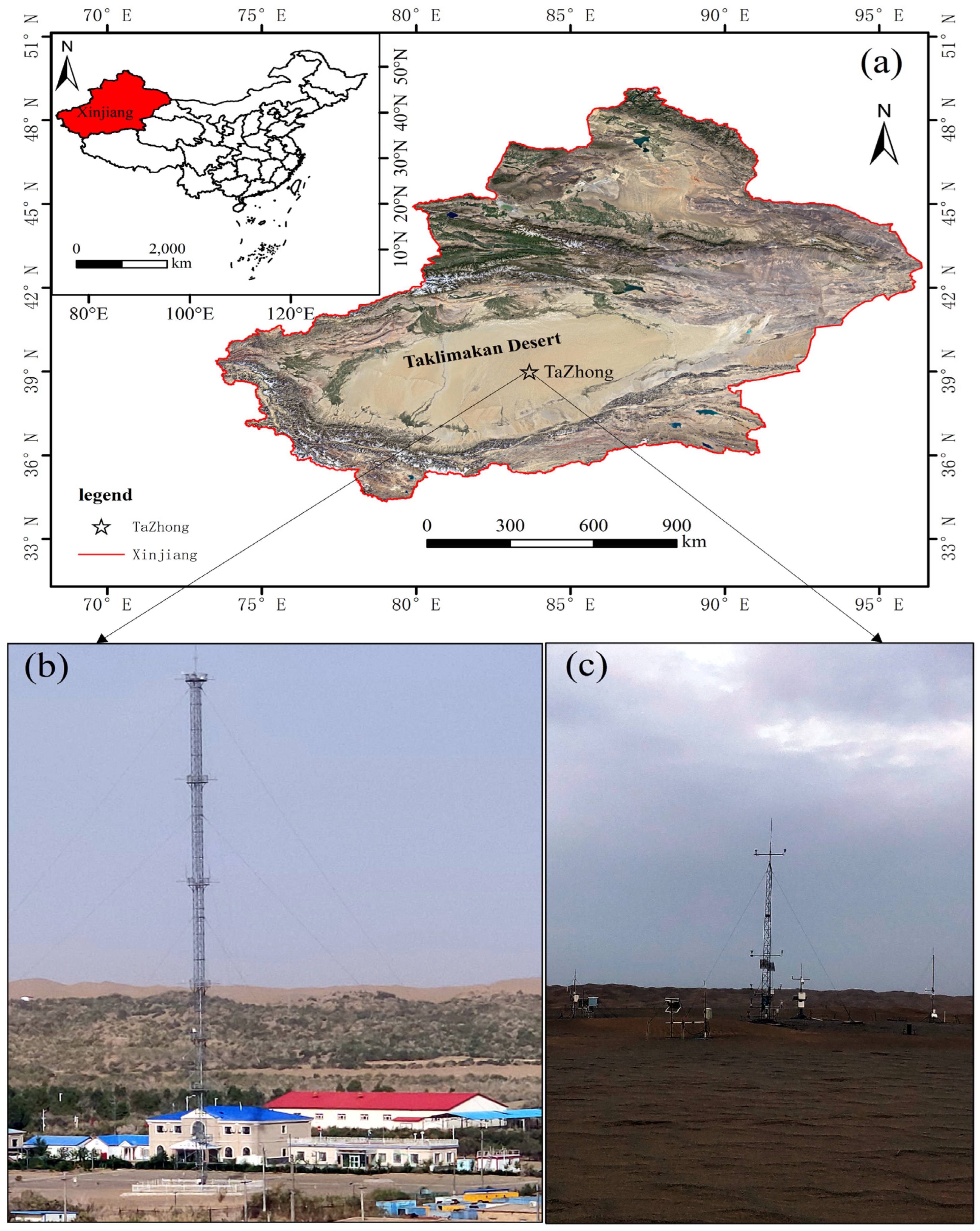
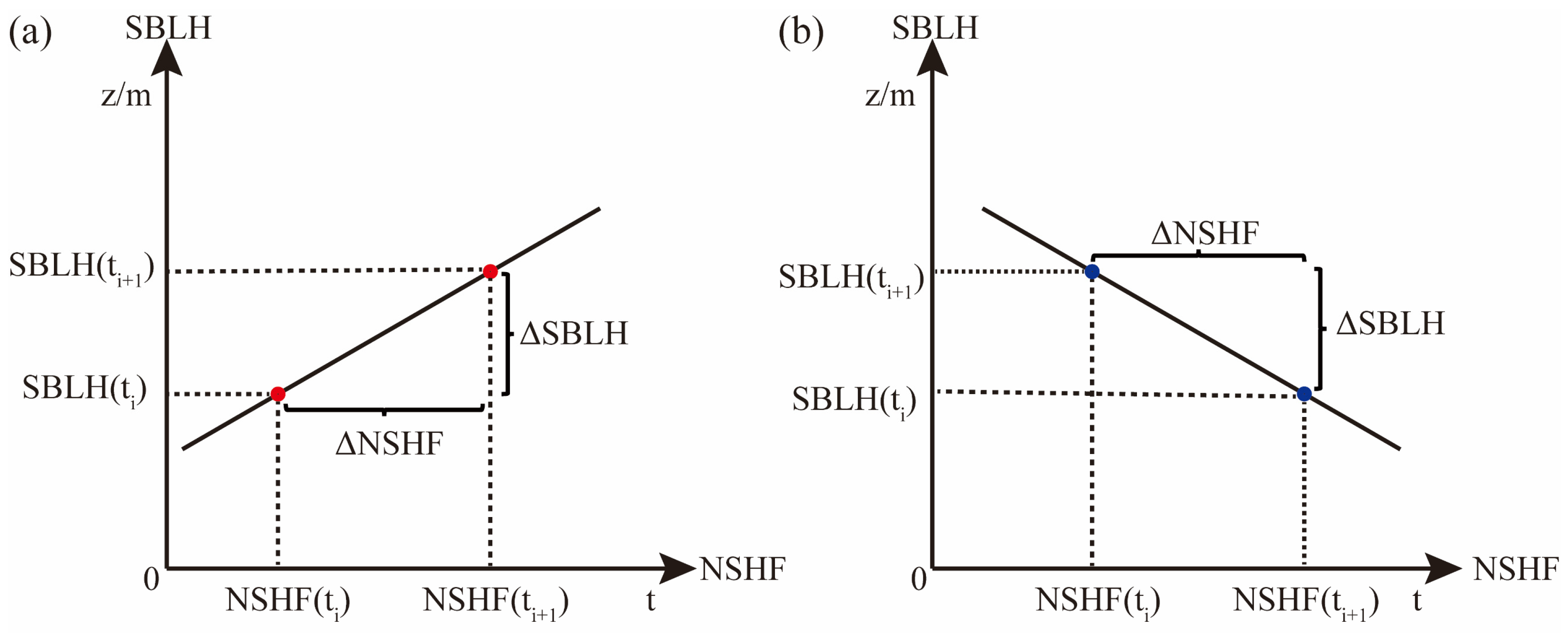

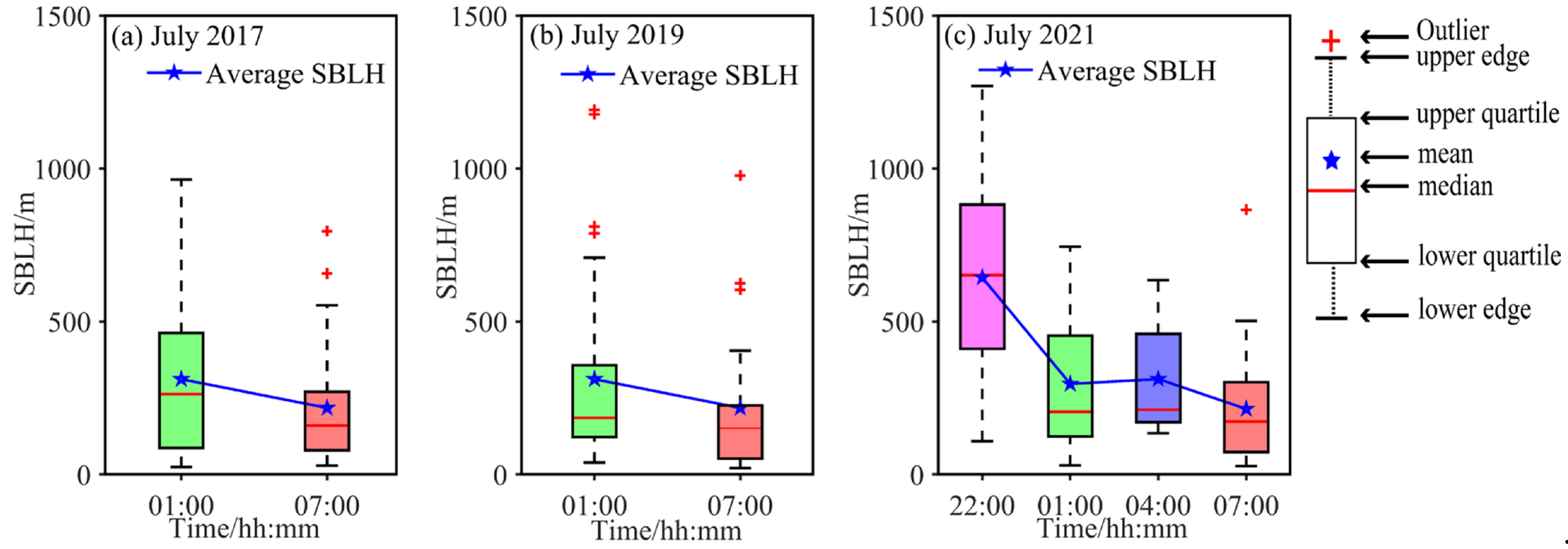

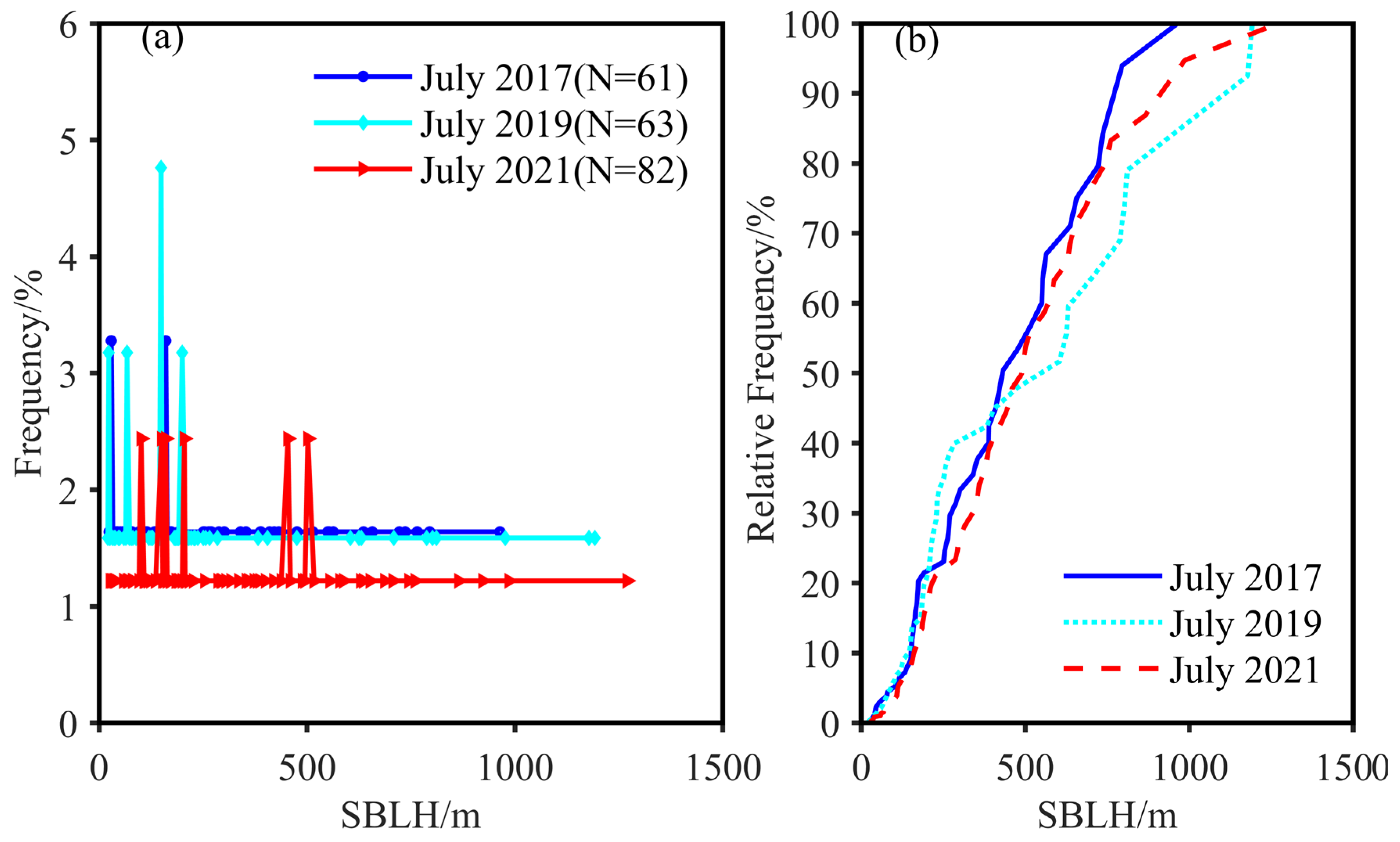

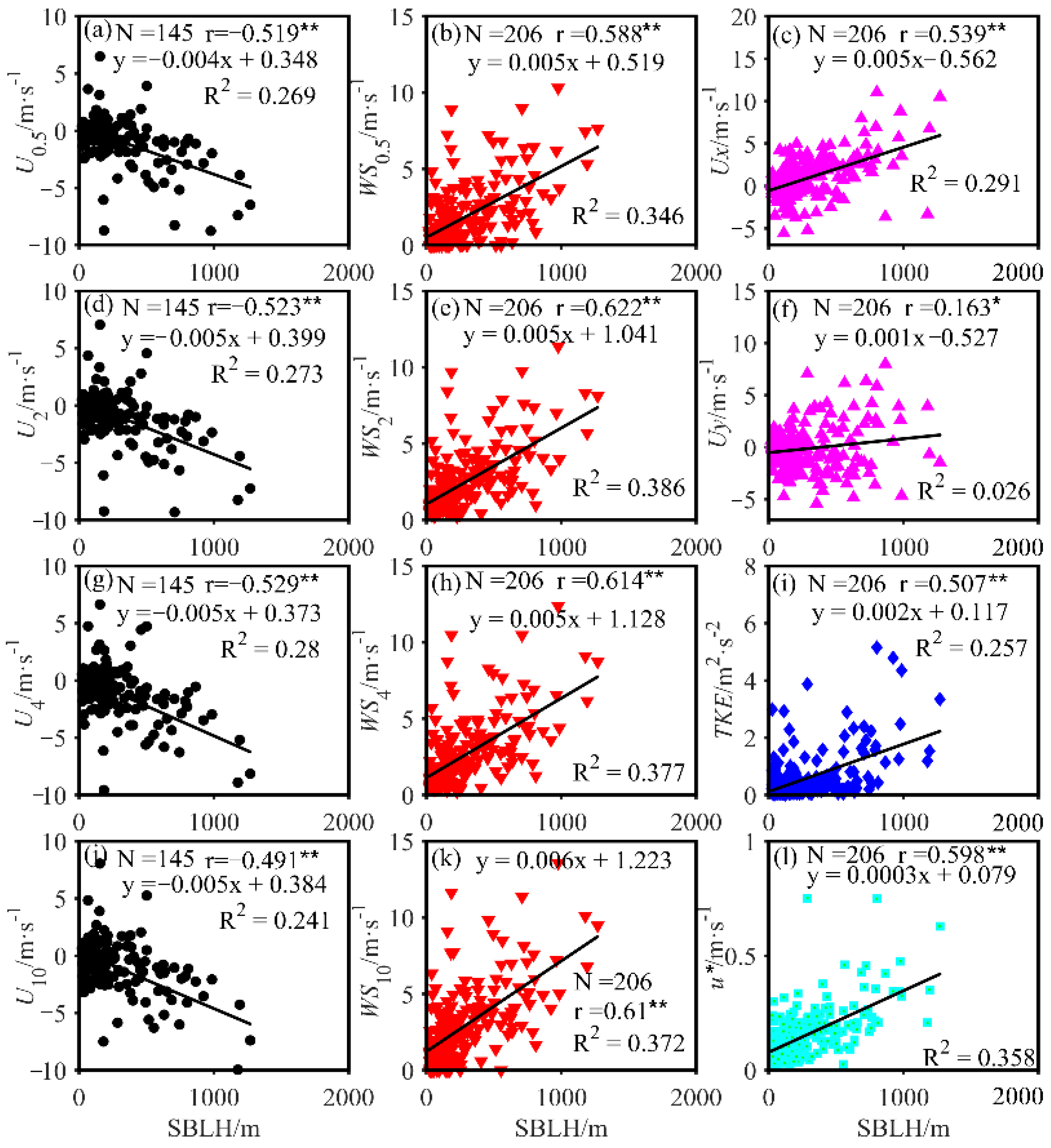
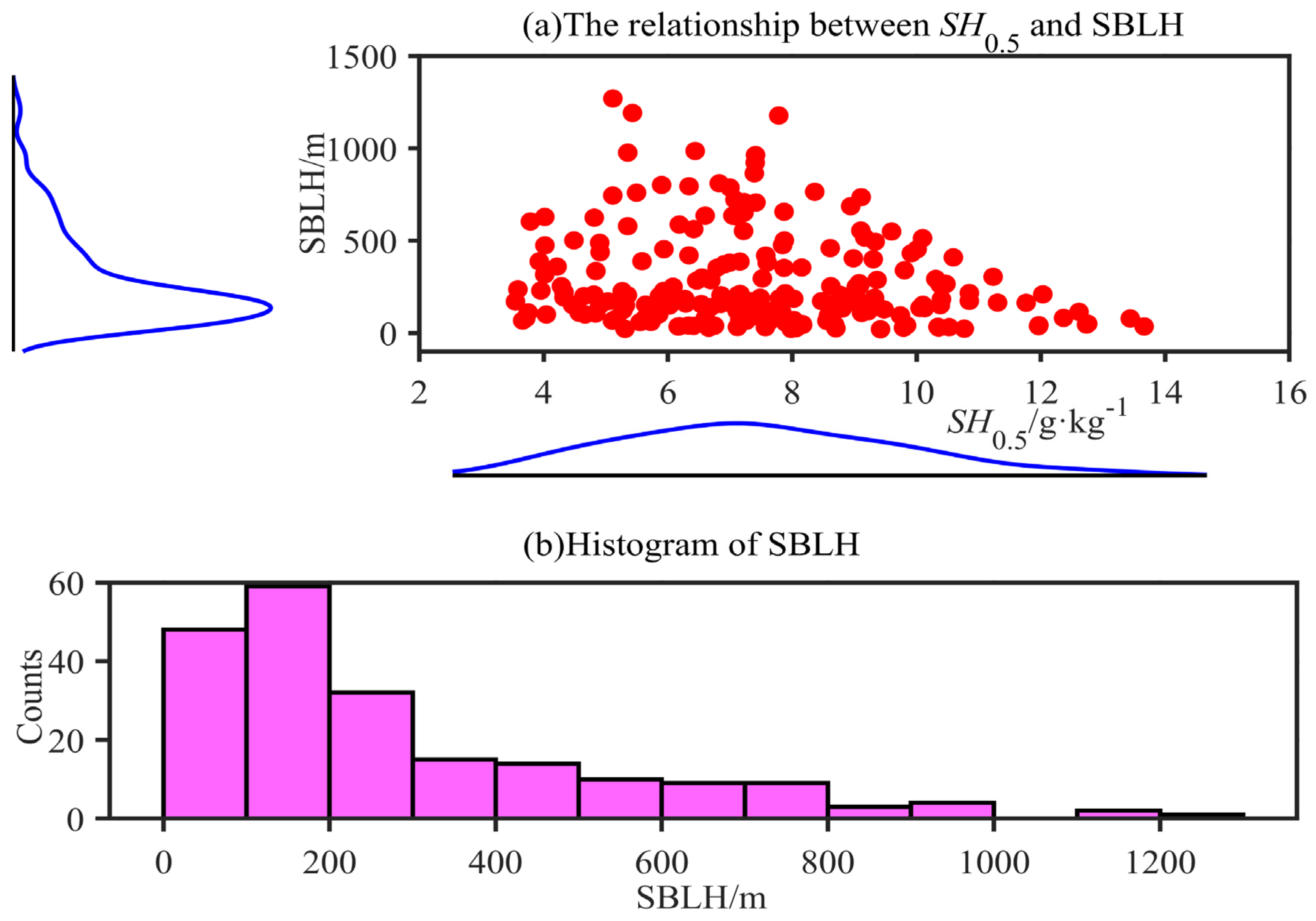
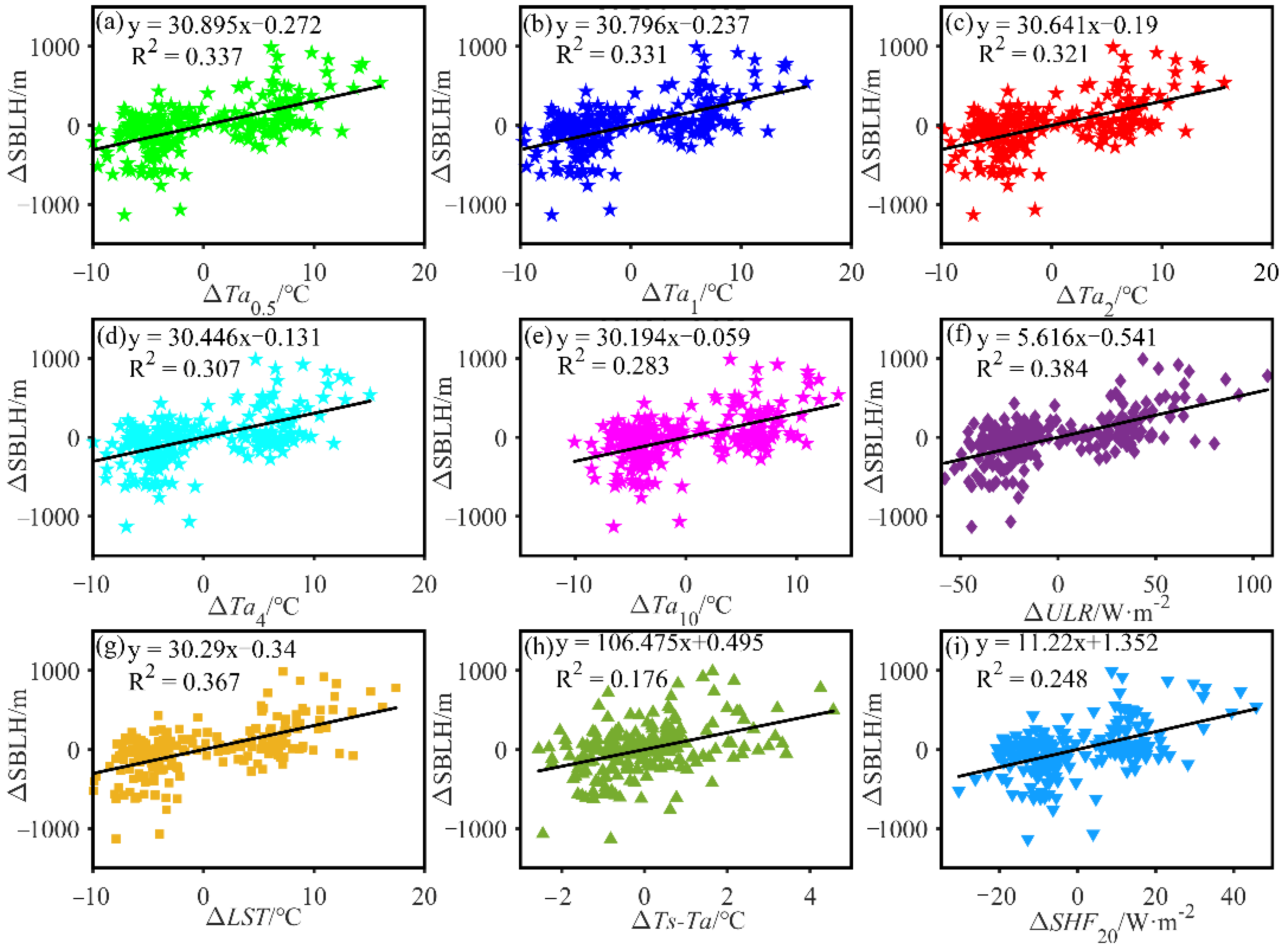
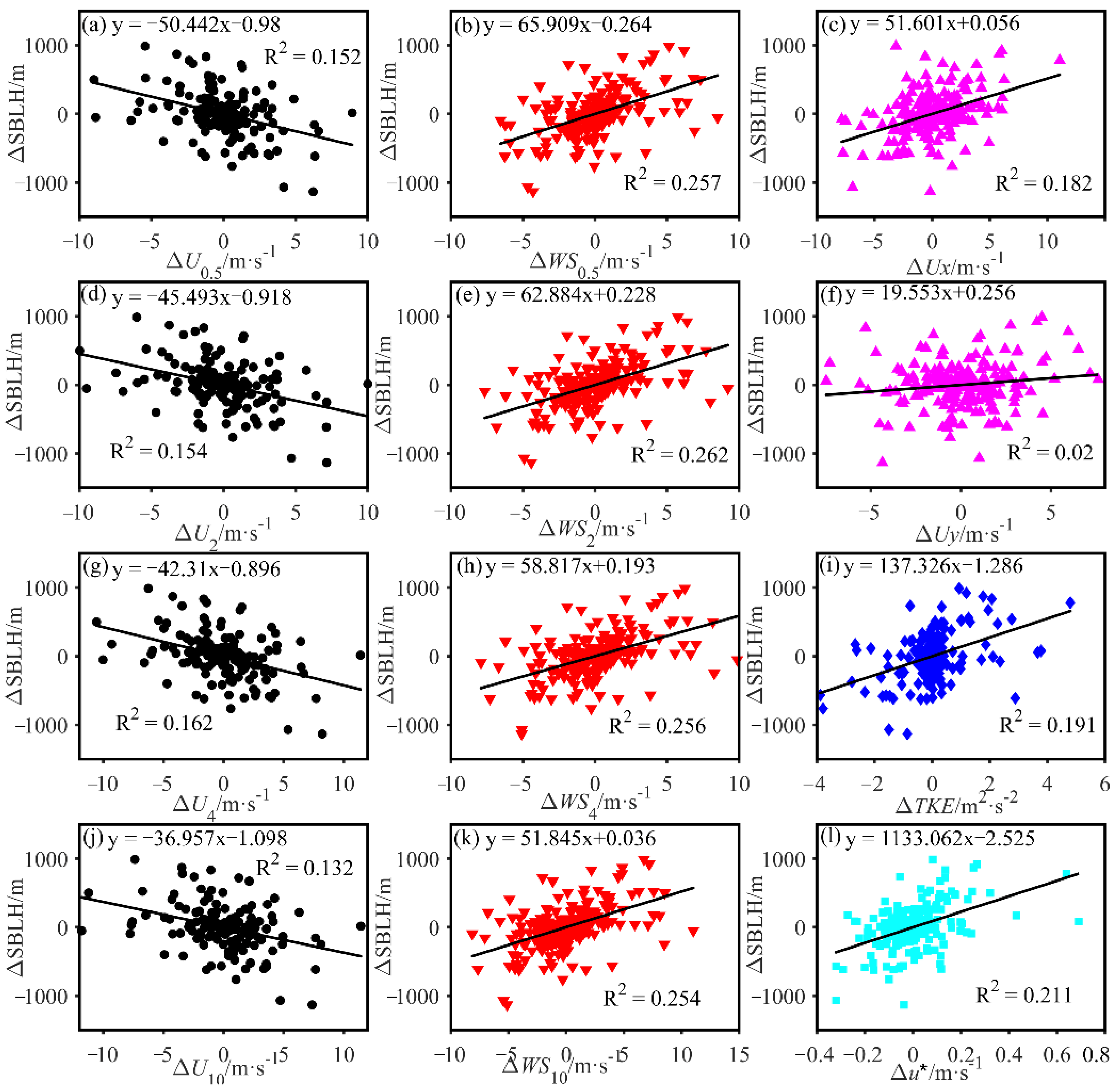

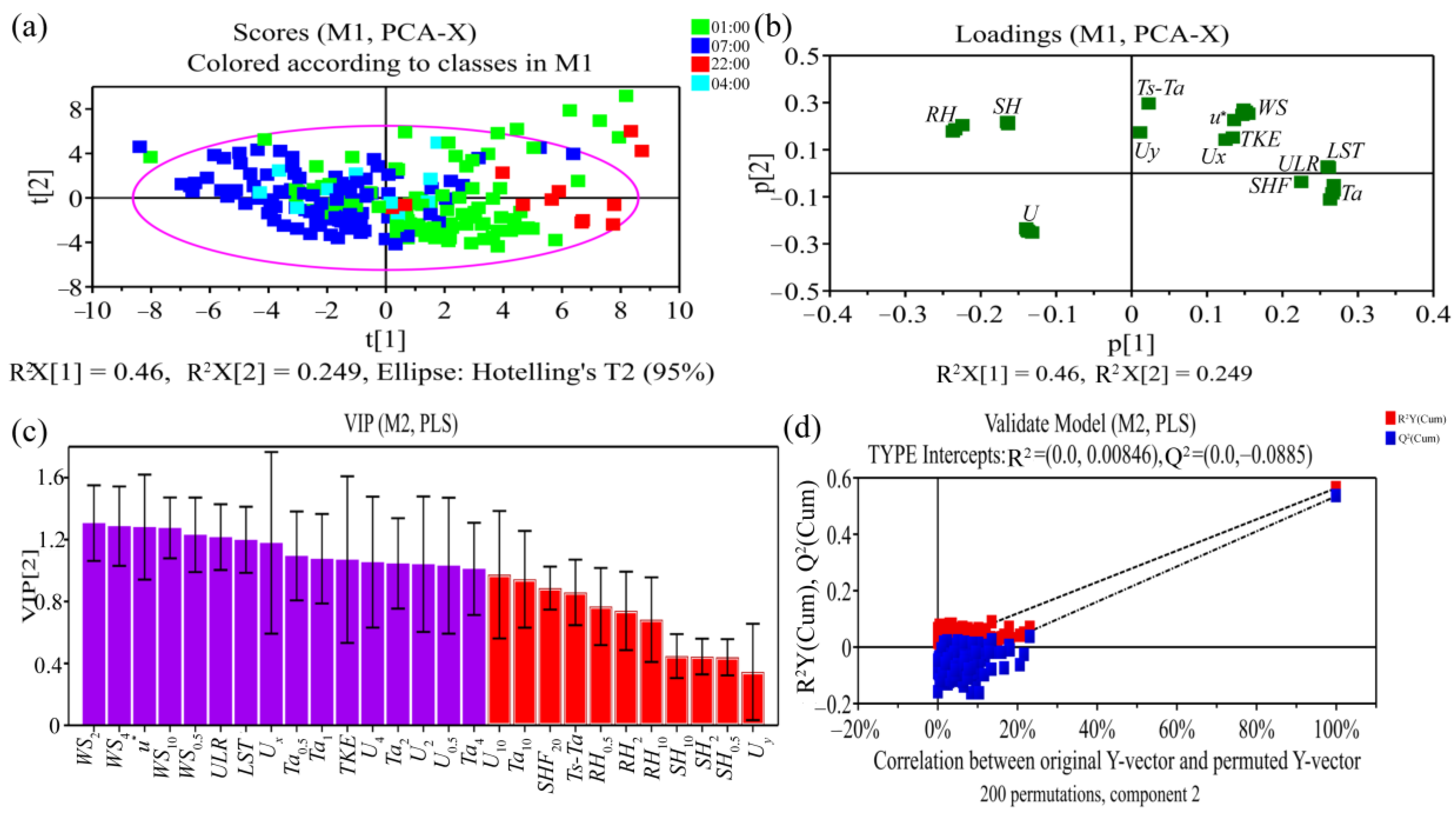
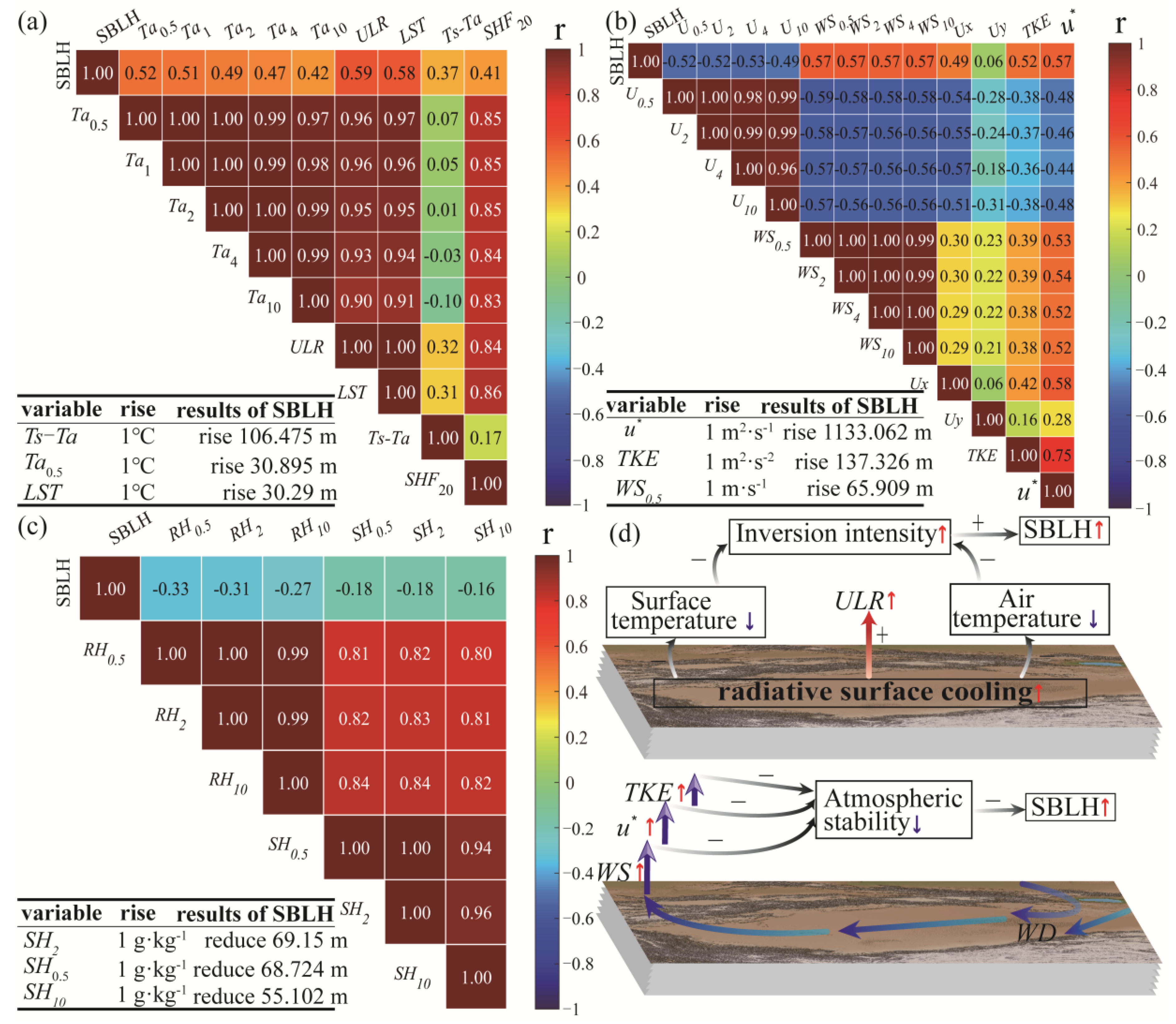
| Time | 22:00BT | 01:00BT | 04:00BT | 07:00BT |
|---|---|---|---|---|
| July 2017 | 0 | 31 | 0 | 30 |
| July 2019 | 1 | 31 | 0 | 31 |
| July 2021 | 11 | 30 | 10 | 31 |
| Instrument | Manufacturer | Variables | Range | Precision | Accuracy |
|---|---|---|---|---|---|
| GPS sounding | Beijing Changfeng Micro-Electronics Technology Co., Ltd., Beijing, China | Temperature (Ta) | −90–+60 °C | 0.1 °C | ±0.2 °C |
| Relative humidity (RH) | 0–100% | 1% | ±3% | ||
| Pressure (P) | 3–1080 hpa | 0.1 hpa | ±1 hpa | ||
| Windspeed (WS) | 0–150 m·s−1 | 0.1 m·s−1 | ±0.15 m·s−1 | ||
| Wind direction (WD) | 0–360° | 0.1° | ±2 °C | ||
| Surface receiver | Beijing Changfeng Micro- Electronics Technology Co., Ltd., Beijing, China | Receiving frequency: 400–406 MHz; automatic frequency control precision: 2 kHz; antenna gain: >7 dB; noise coefficient: 2.7 dB | |||
| 3D ultrasonic anemometer | Campbell Scientific, Inc., Logan, UT, USA | Sample frequency: 20 Hz; WS range: 0–45 m·s−1; precision: <1%; resolution: 0.01 m·s−1; deviation: <±0.01 m·s−1; WD precision: <±1°; resolution: 1° | |||
| 10 m gradient meteorological tower | Anemomter (Wind Obeserver II-65, Gill Instruments, England and Wales), thermohy grometer (HMP155A, Vaisala, Helsinki, Finland), barometer (PTB330, Vaisala, Helsinki, Finland), soil thermometer (109, Campbell, Logan, UT, USA), soil hygrometer (93640Hydra, Stevens, Portland, OR, USA), and heat flux plate (HFP01SC, Hukseflux, The Netherlands) | The 10 m gradient meteorological tower was installed in the shifting sand area about 2.2 km west of the TZ. | |||
| The anemometers and thermohy grometers were installed at 0.5, 1, 2, 4 and 10 m along the meteorological tower. | |||||
| The barometer was installed at 1.5 m on the meteorological tower. | |||||
| The soil thermometers were installed at depths of 0, 5, 10, 20, and 40 cm in the sand. | |||||
| The soil hygrometers and heat flux plates were installed at depths of 5, 10, 20, and 40 cm in the sand. | |||||
| Four-component radiometer | CNR-1, Kipp&Zonen, Delft, The Netherlands | Main measurements: solar radiation (DR), sky long wave radiation (DLR), surface reflected radiation (UR), and surface emitted long wave radiation (ULR). Installed at a height of 1.5 m, spectral range 305–2800 nm; sensitivity 10 µv·w−1·m−2. The response time reached 95% in 5 s; direction error ≤ ±10 W·m−2. | |||
| Parameter | Maximum | Minimum | Mean | Standard Deviation | Median | Interquartile Range | |
|---|---|---|---|---|---|---|---|
| Time | |||||||
| July 2017 | 964 | 34 | 265 | 233 | 169 | 310 | |
| July 2019 | 1192 | 21 | 263 | 278 | 184 | 169 | |
| July 2021 | 1270 | 27 | 313 | 253 | 209 | 327 | |
| Variable | RH0.5 | RH1 | RH2 | RH4 | RH10 |
|---|---|---|---|---|---|
| Linear equation | y = −0.022x + 38.65 | y = −0.022x + 38.49 | y = −0.021x + 37.57 | y = −0.019x + 35.96 | y = −0.017x + 34.9 |
| Residual norm | 230.48 | 231.5 | 230.6 | 225.08 | 222.22 |
| r | −0.334 ** | −0.326 ** | −0.314 ** | −0.299 ** | −0.271 ** |
| R2 | 0.111 | 0.106 | 0.098 | 0.089 | 0.074 |
| MAPD | 39.3% | 39.51% | 40.15% | 40.54% | 40.56% |
| Variable | SH0.5 | SH1 | SH2 | SH4 | SH10 |
|---|---|---|---|---|---|
| Linear equation | y = −0.002x + 7.92 | y = −0.002x + 7.95 | y = −0.002x + 7.99 | y = −0.002x + 8.07 | y = −0.001x + 8.32 |
| Residual norm | 30.95 | 30.88 | 30.78 | 30.71 | 31.57 |
| r | −0.18 ** | −0.18 ** | −0.179 * | −0.177 * | −0.165 * |
| R2 | 0.032 | 0.032 | 0.032 | 0.031 | 0.027 |
| MAPD | 23.34% | 23.24% | 23.04% | 22.71% | 22.54% |
Disclaimer/Publisher’s Note: The statements, opinions and data contained in all publications are solely those of the individual author(s) and contributor(s) and not of MDPI and/or the editor(s). MDPI and/or the editor(s) disclaim responsibility for any injury to people or property resulting from any ideas, methods, instructions or products referred to in the content. |
© 2024 by the authors. Licensee MDPI, Basel, Switzerland. This article is an open access article distributed under the terms and conditions of the Creative Commons Attribution (CC BY) license (https://creativecommons.org/licenses/by/4.0/).
Share and Cite
Yang, G.; Shu, W.; Wang, M.; Mao, D.; Pan, H.; Zhang, J. Analysis of Height of the Stable Boundary Layer in Summer and Its Influencing Factors in the Taklamakan Desert Hinterland. Remote Sens. 2024, 16, 1417. https://doi.org/10.3390/rs16081417
Yang G, Shu W, Wang M, Mao D, Pan H, Zhang J. Analysis of Height of the Stable Boundary Layer in Summer and Its Influencing Factors in the Taklamakan Desert Hinterland. Remote Sensing. 2024; 16(8):1417. https://doi.org/10.3390/rs16081417
Chicago/Turabian StyleYang, Guocheng, Wei Shu, Minzhong Wang, Donglei Mao, Honglin Pan, and Jiantao Zhang. 2024. "Analysis of Height of the Stable Boundary Layer in Summer and Its Influencing Factors in the Taklamakan Desert Hinterland" Remote Sensing 16, no. 8: 1417. https://doi.org/10.3390/rs16081417
APA StyleYang, G., Shu, W., Wang, M., Mao, D., Pan, H., & Zhang, J. (2024). Analysis of Height of the Stable Boundary Layer in Summer and Its Influencing Factors in the Taklamakan Desert Hinterland. Remote Sensing, 16(8), 1417. https://doi.org/10.3390/rs16081417






